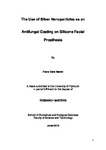The Use of Silver Nanoparticles as an Antifungal Coating on Silicone Facial Prosthesis
| dc.contributor.supervisor | Handy, Richard | |
| dc.contributor.author | Meran, Zhala | |
| dc.contributor.other | Faculty of Science and Engineering | en_US |
| dc.date.accessioned | 2014-01-31T14:33:09Z | |
| dc.date.available | 2014-01-31T14:33:09Z | |
| dc.date.issued | 2013 | |
| dc.date.issued | 2013 | |
| dc.identifier | 10381005 | en_US |
| dc.identifier.uri | http://hdl.handle.net/10026.1/2877 | |
| dc.description.abstract |
Abstract Introduction Maxillofacial prostheses are used to substitute lost facial parts, but give variable clinical results due to complications such as contamination and infection. Candida albicans infection remains a significant problem for facial prostheses made of silicone, as the organism causes degradation of the material and infection of the surrounding tissue. This study investigated the antifungal properties of silver nanoparticles (Ag NPs) as a coating on silicone facial prostheses to eliminate infection. Methods The experimental approach used fibroblast cell cultures to test the biocompatibility of Ag NPs and to demonstrate the safety of Ag NPs compared to AgNO3 at concentrations of 5 and 50 mg l-1. Cells cultures with and without the prosthetic material coated with Ag NPs were tested for cell viability and adherence to the prosthetic. An addition of yeast (C. albicans) was used as a pathogenic challenge to test the “antifungal” properties of the new facial prosthetics. End points included the determination of the cytotoxic response of the cells to nanoparticles including; protein and lactate dehydrogenase enzyme (LDH) leak, as well as electrolytes relating to the osmotic health of the cells (measuring pH, Na+, K+). Total Ag concentrations were also measured. In addition, an ethanol assay was used to follow metabolic activity associated with C. albicans, as fibroblasts do not produce ethanol. Results This study revealed that facial prostheses coated with Ag NPs preserved fibroblast cells from fungal infection compared to uncoated silicone prosthesis at a concentration of 50 mg l-1. Cell viability measures showed Ag NPs were not toxic to fibroblast cells compared to AgNO3 after 24h exposure. LDH leak was 9.7 % at a concentration of 50 mg l-l Ag NPs, while LDH leak for cells exposed to AgNO3 was 97%. Additionally, fibroblast cells exposed to AgNO3 showed significant change in cell Na+ content, as a coating, and when silver was added directly to the culture media (Kruskal Wallis, p< 0.05). However, when cells were exposed for 24 h to Ag NPs prepared in the media, this caused a significant change in cell K+ content (One way ANOVA, p< 0.05) and inhibition of Na+ K+-ATPase activity. In contrast, when the cells were exposed to the same concentrations of Ag NPs as a coating on silicone prostheses for 72 h, there was no effect on the Na+ pump or on cell K+. This study also showed that silver released from Ag NPs as a coating was less compared to that from AgNO3. Moreover, the production of ethanol by C. albicans was 30-fold lower when the silicone coated with Ag NPs compered to uncoated silicone, and 8-fold lower when coated with AgNO3. Conclusion The coating of silicone materials with Ag NPs could be of great use clinically to prevent fungal infection for patients with maxillofacial prostheses. A practical coating on the surface of the silicone prosthesis of 50 mg l-1 Ag NPs should be antifungal without any toxic effects to human dermal fibroblast cells. In clinical situations Candida infection occur at lower inoculations than used here and a lower concentration of Ag NPs could therefore also be effective in real patients. | en_US |
| dc.description.sponsorship | Kurdistan Regional Government | en_US |
| dc.language.iso | en | en_US |
| dc.publisher | University of Plymouth | en_US |
| dc.subject | The Use of Silver Nanoparticles in Dental Prosthetics | en_US |
| dc.title | The Use of Silver Nanoparticles as an Antifungal Coating on Silicone Facial Prosthesis | en_US |
| dc.type | Masters | en_US |
| plymouth.version | Full version | en_US |
Files in this item
This item appears in the following Collection(s)
-
01 Research Theses Main Collection
Research Theses Main


